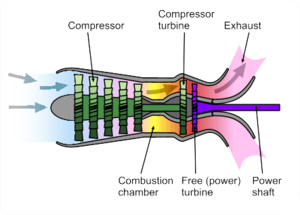Engine operations
Contents
Engine Operations
During normal flight the engines mostly takes care of themselves. But EECH does allow you to control the engines manually and to start and stop them.
- Main article: engine startup
About the turboshaft turbine engine
Modern combat helicopters use almost exclusively turbine engines (also known as turboshaft), mostly because they have a much higher power to weight ratio than a piston engine. So also with the helicopters in EECH. All the flyable helicopters have two turboshaft engines, ranging in power from 1,700 to 2,700 horsepower each.
A turboshaft engine works like a jet engine, but instead of using the jet for propulsion directly, the jet drives a tubine which then delivers the power through a rotating shaft. Modern helicopters have two turbines in each engine. One which compresses air before combustion, known as the gas producer (shortened NG or N1), and one which transforms the combustion energy to rotating power, known as the power turbine (shortened NP or N2).
The NP turbine is constructed to run at a constant RPM, and is often directly connected to the main rotor (through a gearbox which reduces the 20,000-30,000 RPM of the turbine to the 300-400 RPM of the main rotor). The engine itself will keep the NP turbine running at 100%, to the extent that it is possible.
The speed of the NP turbine depends on two factors. First the amount of gas produces by the combustion, and second by the power demanded of it by the rotor and other systems. Increasing collective will make the main rotor demand more power, and vice versa. To compensate for the increased power demand the engine will increase the RPM of the gas producer turbine. The engine manages this automatically and so you normally don't have to worry about it. But changing RPM of the engine is not instantaneous, so if you make huge adjustments on the collective the engine might not be able to keep up immediately. This means NP and rotor RPM might deviate from 100% when making big control adjustments.
In EECH it is possible to influence the RPM of the NG turbine, although the engine control system will not allow you to put so much power into the NG turbine that the NP turbine will go over 100% RPM. But you can reduce RPM on the NG turbine. This is mostly only useful when the engine is damaged, or otherwise in danger of overheating.
If one engine runs with a lower NG RPM, the NP RPM of both engines might still be 100%. This is because the other engine will compensate and produce more power to keep rotor RPM at 100%. If both engines are overheating it will do little good to lower NG RPM of both engines, since they will each still have to produce half of the requested power. Rather you should adjust collective to require less torque.
The engine is not able to run if the NG runs at less than about 58% RPM. This is because just keeping the NG turbine running requires more power than the engine produces at lower RPMs. So to get the engine started, the helicopters uses a third turbine engine to start the other two! This third turbine engine, known as the Auxiliary Power Unit (APU), is much smaller than the other two engines. In the Apache the APU generates about 120 horsepower. The APU itself is started by stored high pressure hydraulic fluid (AH-64, UH-60) or a battery powered starter-generator unit (Mi-28, Ka-50).
Acronyms
| TG | turbine gas temperature |
| TQ | turbine torque (RPM) |
| NG | RPM % generator turbine (compressor turbine) |
| NP | RPM % power turbine |
| NR | RPM % main rotor |
| APU | RPM % of auxiliary power unit |
Havoc analog engine instruments
Havoc engine instruments: torque to the left, and on the right the red bars are temperature and the yellow are NG RPM. Havoc rotor RPM (white needle) and NP turbine RPM (grey needles).
In the Havoc the engine RPM gauge now shows NG RPM, not NP RPM as is used to do. The rotor RPM gauge has been modified to include dials also for the NP turbines (grey in colour as opposed to the rotor RPM needle which is white). Normally both NP and NR are at 100%, so the rotor RPM needle will be on top of the other needles, and hence you only see the rotor needle. If you can see more needles (called a needle split), you know something is out of the ordinary.
The Havoc has no instruments for throttle position or APU RPM.
References
External links
- Turboshaft - at Wikipedia.
See also
- engine startup - The manual start up procedure.

